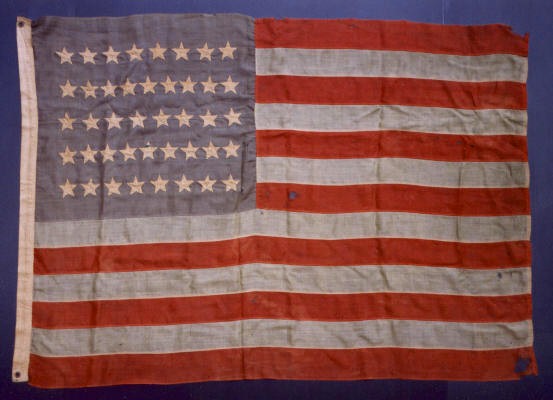
| |
42 Star American Flag -- Unusual Row Configuration -- Dusty Blue -- Small Size |
|
| Available: |
Sold |
| Frame Size (H x L): |
|
| Flag Size (H x L): |
47" x 65" (3" 11" x 5' 5") |
|
| Description....: |
|
| 42 star American National flag. The dusty blue canton of wool bunting contains 5 rows of hand-sewn, cotton muslin stars. These appear in counts of 8-9-8-9-8, which is an unusual arrangement because one very seldom finds row counts of greater than 8 stars. The stripes of the flag are treadle-sewn of wool bunting, and there is a twill cotton sleeve with 2 brass grommets.
Note how the coloration of the canton has faded to a dusty blue-grey. When this trait is found in this particular weave of blue bunting, it is most often in flags that date between 1885 and 1895, and more often in the second half of that ten-year date bracket. After 1895, either flag manufacturers caught on to the fugitive dye and ordered different wool, or the textile company that was producing it changed its dying process. In any event, flags that were made with this wool and have survived to the present have an interesting presentation that many collectors find attractive.
The 42 star flag is interesting from a historical perspective, both because 42 was never an official star count, and because 42 star flags were only produced for about 8 months (November, 1889 - July 4th, 1890). The flag represents the addition of the Dakotas, Montana and Washington, between November 2nd and November 11th, 1889. The 42nd state was officially Washington, but the four states gained their statehood only nine days apart, and flag makers added four stars, accordingly, to the 38 star flag that was previously official.
After 1818, star counts became official on the 4th of July each year. A new star was therefore officially added on Independence Day for every state that had been added over the preceding "flag year". Flag makers, however, did not wait for Independence Day and "official" star counts. Flag making was a competitive industry, and no one wanted to be making 38 star flags, for example, when their competitors were making 42 star flags and there were 42 states. On many occasions, particularly in the last quarter of the 19th century and the first decade of the 20th century, flag-makers would speculate the number of states that were going to be added and add the stars before they were official. It was for this precise reason that 42 was never an official star count. Idaho received statehood on July 3rd, 1890, taking the star count to 43 just one day before 42 would have become the official number. This fact makes 42 star flags an interesting part of our heritage and a classic display of American capitalism.
Mounting: The flag has not yet been pressed or mounted.
Condition: The flag shows expected age for the period. There are small separations between the sleeve and the body of the flag at both the top and bottom of the hoist end. There are holes with accompanying fabric loss from wind whip at the fly end. There is a small green stain in one of the stars, and a small amount of the same green is present in the 3rd red stripe. There is a small hole near the center of the flag and there are scattered areas of minor fabric loss throughout. There is a consistent golden oxidation throughout the white stripes and stars. Many collectors prefer this overall condition in early flags, felling that it adds nostalgic charm to the well-loved symbol of our nation. |
|
|
|
| Collector Level: |
Beginners and Holiday Gift Giving |
|
| Flag Type: |
Sewn flag |
|
| Star Count: |
42 |
|
| Earliest Date of Origin: |
1889 |
|
| Latest Date of Origin: |
1890 |
|
| State/Affiliation: |
Washington |
|
| War Association: |
1866-1889 Indian Wars |
|
| Price: |
No |
|
| |
Views: 6662 |
|
|
|

